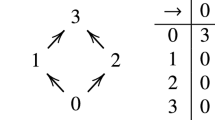Abstract
The purpose of the paper is to show that by cleaning Classical Logic (CL) from redundancies (irrelevances) and uninformative complexities in the consequence class and from too strong assumptions (of CL) one can avoid most of the paradoxes coming up when CL is applied to empirical sciences including physics. This kind of cleaning of CL has been done successfully by distinguishing two types of theorems of CL by two criteria. One criterion (RC) forbids such theorems in which parts of the consequent (conclusion) can be replaced by arbitrary parts salva validitate of the theorem. The other (RD) reduces the consequences to simplest conjunctive consequence elements. Since the application of RC and RD to CL leads to a logic without the usual closure conditions, an approximation to RC and RD has been constructed by a basic logic with the help of finite (6-valued) matrices. This basic logic called RMQ (relevance, matrix, Quantum Physics) is consistent and decidable. It distinguishes two types of validity (strict validity) and classical or material validity. All theorems of CL (here: classical propositional calculus CPC) are classically or materially valid in RMQ. But those theorems of CPC which obey RC and RD and avoid the difficulties in the application to empirical sciences and to Quantum Physics are separated as strictly valid in RMQ. In the application to empirical sciences in general the proposed logic avoids the well known paradoxes in the area of explanation, confirmation, versimilitude and Deontic Logic. Concerning the application to physics it avoids also the difficulties with distributivity, commensurability and with Bell’s inequalities.
Similar content being viewed by others
References
Aerts, D., ‘A Possible Explanation for the Probabilites of Quantum Mechanics and Example of a Macroscopical System that Violates Bell Inequalities’, in P. Mittelstaedt and E.W. Stachow, (eds.), Recent Developments in Quantum Logics, B. I. Wissenschaftsverlag, 1985, pp. 235–249.
Aerts, D., S. Aerts, ‘Towards a General Operational and Realistic Framework for Quantum Mechanics and Relativity Theory’, in A. Elitzur, et al. (eds.), Quo Vadis Quantum Mechanics? Heidelberg, Springer, pp. 153–207.
Bell J.: Speakable and Unspeakable in Quantum Mechanics. Cambridge Univ. Press, Cambridge (1987)
Birkhoff G., Neumann J.v.: ‘The Logic of Quantum Mechanics’. Annals of Mathematics 37, 823–843 (1936)
Czermak, J., ‘Eine endliche Axiomatisierung von SS1M’, in E. Morscher, O. Neumaier, and G. Zecha, (eds.), Philosophie als Wissenschaft/Essays in Scientific Philosophy, Comes, Bad Reichenhall 1981, pp. 245–258.
Dalla Chiara M.L.: ‘Quantum Logic and Physical Modalities’. Journal of Philosohical Logic 6, 391–404 (1977)
Dalla Chiara, M.L., and R. Giuntini, Quantum Logics, arXiv:quant-ph/0101028v2
Dalla Chiara M.L., Giuntini R., Greechie R.: Reasoning in Quantum Theory, Sharp and Unsharp Quantum Logics. Kluwer, Dordrecht (2004)
D’Espagnat, B., A la Recherche du Rel, Paris, Gauthier-Villars, 1979.
Finch P.D.: ‘Quantum logic as an implication algebra’. Bulletin of the Australian Mathematical Society 2, 101–106 (1970)
Finkelstein, D., ‘Matter, Space and Logic’, in C.A. Hooker, (ed.), The Logico- Algebraic Approach to Quantum Mechanics, Vol. II, 1979, pp. 123–139.
Goldblatt R.I.: ‘Semantic Analysis of Orthologic’. Journal of Philosophical Logic 3, 19–35 (1974)
Mittelstaedt P.: ‘On the interpretation of the lattice of subspaces of Hilbert space as a propositional calculus’. Zeitschrift für Naturforschung 27, 1358–1362 (1972)
Mittelstaedt P.: Quantum Logic. Reidel, Dordrecht (1978)
Mittelstaedt P.: The Interpretation of Quantum Mechanics and the Measurement Process. Cambridge Univ. Press, Cambridge (1998)
Mittelstaedt, P., ‘Does Quantum Physics Require a New Logic?’, in P.Weingartner (ed.), [33], pp. 269–284.
Mittelstaedt P., Weingartner P.: Laws of Nature. Springer, Heidelberg (2005)
Pavicic M., Megill N.D.: ‘Standard Logics are Valuation-Nonmonotonic’. Journal of Logic and Computation 18(6), 959–982 (2009)
Pavicic, M., and N. D. Megill, ‘Is Quantum Logic a Logic?’, in K. Engesser, D.M. Gabbay, and D. Lehmann (eds.), Handbook of Quantum Logic and Quantum Structures: Quantum Logic, Elsevier B.V., 2009.
Piron C.: ‘Axiomatique Quantique’. Helv. Phys. Acta 37, 439–468 (1964)
Rescher N.: Many Valued Logic. McGraw Hill, New York (1969)
Schechter E.: Classical and Nonclassical Logic. An Introduction to the Mathematics of Propositions. Princeton Univ. Press, Princeton (2005)
Schurz, G., and P. Weingartner, ‘Versimilitude Defined by Relevant Consequence- Elements. A New Reconstruction of Popper’s Original Idea’, in Th. Kuipers, (ed.), What is Closer-to-the-Truth?, Amsterdam, Rodopi, 1987, pp. 47–77.
Schurz G.: ‘Relevant Deduction’. Erkenntnis 35, 391–437 (1991)
Schurz, G., and P. Weingartner, ‘Zwart and Franssen’s impossibility theorem holds for possible-world-accounts but not for consequence-accounts to versimilitude’, Synthese (forthcoming).
Stachow, E.W., ‘Experimental Approach to Quantum-Logical Connectives’, in P. Weingartner (ed.), [33], pp. 285–298.
Tarski A.: Logic Semantics and Metamathematics. Oxford University Press, Oxford (1956)
Weingartner P.: ‘Modal Logics with two kinds of necessity and possibility’. Notre Dame Journal of Formal Logic 9(2), 97–159 (1968)
Weingartner P., Schurz G.: ‘Paradoxes Solved by Simple Relevance Criteria’. Logique et Analyse 113, 3–40 (1986)
Weingartner, P., Basic Questions on Truth, (Series Episteme 24), Dordrecht, Kluwer, 2000.
Weingartner P. et al.: ‘Reasons for Filtering Classical Logic’. In: Batens, D. (eds) Frontiers in Paraconsistent Logics, pp. 315–327. Research Studies Press, London (2000)
Weingartner, P., ‘Applications of Logic Outside Logic and Mathematics: Do such Applications Force Us to Deviate from Classical Logic?’, in W. Stelzner, (ed.), Zwischen traditioneller und moderner Logik. Paderborn, Mentis, 2001, pp. 53–64.
Weingartner, P. (eds): Alternative Logics. Do Sciences Need Them?. Springer, Heidelberg (2004)
Weingartner, P., ‘Reasons from Science for Limiting Classical Logic’, in P. Weingartner (ed.), [33], pp. 233–248.
Weingartner P.: ‘Matrix Based Logic for Application in Physics’. Review of Symbolic Logic 2(1), 132–163 (2009)
Weingartner, P., ‘Basis Logic for Application in Physics and ist Intuitionistic Alternative’, in Paul Busch (ed.), Essays in Honour of Peter Mittelstaedt, Foundations of Physics, 2010.
Zeilinger, A., ‘Physik und Wirklichkeit. Neuere Entwicklungen zum Einstein- Podolsky-Rosen Paradoxon’, in H.C. Reichel, and E. Prat de la Riba, (eds.), Naturwissenschaft und Weltbild, Vienna, Hlder-Pichler-Temsky, 1992, pp. 99–121.
Author information
Authors and Affiliations
Corresponding author
Rights and permissions
About this article
Cite this article
Weingartner, P. An Alternative Propositional Calculus for Application to Empirical Sciences. Stud Logica 95, 233–257 (2010). https://doi.org/10.1007/s11225-010-9259-1
Published:
Issue Date:
DOI: https://doi.org/10.1007/s11225-010-9259-1



